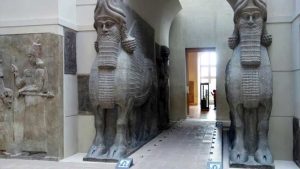Unit one explored the ancient world by using art to understand the importance and significance of a civilization. Before entering the Paleolithic and Neolithic eras, we first scrutinized art and its meaning. Art is many things, but it can be defined as a form of human expression that often is a visual cue and aesthetically composed to create an emotional, social, political, and religious statement. As we discovered in the early classes, to understand an artwork we must understand formal analysis. Formal analysis is best described as using the elements of art to read and understand the story or meaning an artist places onto a canvas. This technique uses, line, color, shape, value (chiaroscuro), texture and space and form, to create empirical questions that help to understand the artwork’s statement.
In the Paleolithic (Old Stone Age) era we spoke mainly about the cave paintings and the Venus of Willendorf (fertility figure). The cave paintings mainly introduced us to not only the first artwork discovered but the idea of sympathetic magic. This can, in fact, be thought of as a religious ritual, which is one of the main themes of this unit. The figurine also is a form of art used to appeal to the fertility deities. This theme is extended into the Neolithic era. In the Neolithic age, society becomes highly stratified into what is commonly known as an agrarian society. The placement of government and administration creates divisions that we commonly know as social classes. This is especially seen in The Standard of Ur, which divides social class into three sections. The 3 sections are placed much like a hierarchy, the king and the priest on top, middle class (rams rather than donkeys) in the middle and slaves/labors on the bottom. The King is the largest figure in work, which is a commonly used technique to symbolism power or importance.
In the Cylinder Seal of Adda (Sumerian society), the continuity of religion is seen because the figures in the cylinder are often seen on deities. The main reason they are seen as deities is due to the crown and difference in size between them and a small man in the middle of the work. In this specific artwork, the deity of water is visible because water is increasingly important for agrarian societies (irrigation=increased agriculture). Another religiously affiliated art pieces are the miniature statues of people praying. They were used as stand-ins, with supplicating hands and large eyes.
There are many more artworks we spoke of but most were commonly associated with war, power, and religion, which easily is related to politics. The use of art created visual cues to express the history of Mesopotamia, Sumeria, Babylonia, and Neo-Sumeria in the primary perceptive of the people. The common technique used during this time were large proportions to emphasis power (which in itself has a political agenda that during this time is often intertwined with religion), special symbols (crowns, clothing, powerful animals) to symbolize social status and importance and many other techniques. In shorter words art using formal analysis and contextual analysis are primary sources of history, that give us a clarified understanding of eras.


